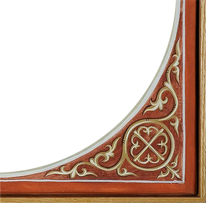Some Things You Should Know While in Church
In the Orthodox Church, there are a lot of customs and traditions that are important parts of our worship. Some are cultural; some are pious customs. Some are essential; some are not. From time-to-time, we need to address some of these various etiquette issues to inform our communities how we can best understand each other and work together to worship the all-holy Trinity.
Standing vs. Sitting
The traditional posture for prayer and worship in the Orthodox Church has been to stand. In the Orthodox "old countries", there are usually no pews in the churches. Chairs or benches on the side walls are usually reserved for the elderly and infirm. When should you definitely stand? Always during the Gospel reading, the Little and Great Entrances, the Anaphora, the distribution of Holy Communion, whenever the priest gives a blessing, and the Dismissal. When in doubt, stand. It is never wrong to stand in church.
Lighting Candles
Lighting candles is an important part of Orthodox worship. We light them as we pray, making an offering to accompany our prayers. Orthodox typically light candles when coming into the church - and that is usually the best time to light them, but there are times when candles should not be lit. It is not proper to light candles during the Epistle or Gospel readings, during the Little or Great Entrances, the sermon, and most of the times when the faithful are standing.
Entering the Church (Late)
The time to arrive at church is before the service starts, but for some unknown reason, many people have developed the bad habit of coming to church late. If you do arrive after the Divine Liturgy begins, try to enter the church quietly - and observe what is happening. If the Epistle or Gospel is being read or the Little or Great Entrance is taking place, wait until it is finished to quickly enter the Sanctuary. If Father is giving the sermon, stay in the back until he has concluded. Try not to interrupt the Liturgy with your entrance.
Lipstick, lip balm and other glosses
Have you ever looked at an icon in just the right light and seen the lip prints all over it? It's disgusting, isn't it? In fact, it's downright gross. Lipstick may look fine on lips, but it looks horrible on icons, crosses, the Communion spoon and the priest's or bishop's hand. Icons have been ruined by lipstick; and even though the cross can usually be cleaned after everyone venerates it, it just isn't considerate to others to impose your lipstick on them. What is the answer? If you insist on wearing lipstick to church, blot your lips well before venerating an icon, taking Communion, or kissing the cross or the priest's or bishop's hand. Even better, wait until after church to put it on. After all, God is not impressed with how attractive you look externally - your makeup or clothing - but how attractive you are internally, your adornment with good works and piety.
Venerating Icons
When you enter the church, it is traditional to venerate the icons. When venerating (kissing) an icon, pay attention to where you kiss. It is not proper to kiss an icon in the face. You wouldn't go up and kiss the Lord or His mother on the lips, would you? You would kiss their hand, and only of they invited you would you even dare to kiss them on the cheek. Pay attention to what you are doing. When you approach and icon to venerate it, kiss the gospel, scroll, or hand cross in the hand of the person in the icon, or kiss the hand or foot of the person depicted. As you venerate and icon, show proper respect to the person depicted in the icon - the same respect you would show the person by venerating him or her in an appropriate place. And remember, blot off your lipstick before kissing.
Talking during Church
It isn't appropriate to greet people and have a conversation with them during the services. Besides being disrespectful towards God, it is rude towards the other people in the church who are trying to worship. It is especially disrespectful to talk on the phone during the service, so turn off that cell phone – or even better, leave it in the car. God does not need a cell phone to speak to your heart and He hears even the quietest whisper of your soul so you don’t need one to speak to Him. Talk to God while in church through your prayers, hymns, and thanksgiving, and to your friends in the hall afterwards.
Sunday Dress
In all areas of our lives, we should offer Christ our best. And the same is true of our dress. We should offer Christ our 'Sunday best", not our everyday or common wear. And we should dress modestly, not in a flashy way that would bring attention to ourselves. Our dress should always be becoming of a Christian - especially at church.
Here are some specific guidelines we can use in our parish:
Only young children (under 10) should wear shorts to church - and then only dress shorts. Athletic shorts, cut-offs, and spandex shorts are never appropriate church wear (for children or adults!). Shoes or sandals should be clean and tied. No one should wear T-shirts with any kind of writing on them.
For women, dresses should be modest. No tank tops or dresses with only straps at the shoulders, no short skirts (mini-skirts), and no skin-tight dresses. Dresses should have backs and not be cut low in the front. Shorts of any type are not appropriate for church. It is traditional for a woman to cover her head in Church, whether with a hat or a scarf or a shawl makes no difference. Your head covering need not be ugly – just respectful.
Men should also dress modestly. While coat and tie are not mandatory, shirts should have collars and be buttoned to the collar (the actual collar button may be left undone, but two or three buttons undone is inappropriate). Slacks should be cleaned and pressed. Jeans (of any color) are usually too casual for church, especially ones with patches or holes. Again, shorts are not appropriate church wear.
If you're going somewhere after church where you need to dress casually, bring a change of clothing with you and change after coffee hour. Remember, use your best judgment and good taste when dressing for church. After all, you don't go to be seen by everyone else - you go to meet and worship God.
Snacks for Children
Parents often bring snacks for children during church. And for young children (0-2 years old), this is fine (especially when they are given in the nursery room). But by the time children are 3-4 years old, they should be able to make it through Liturgy without eating anything.
Handling the Holy Bread
After taking Holy Communion and at the end of the liturgy, it is traditional to eat a piece of holy bread or antidoron - the bread that was left over after Holy Communion was prepared. While antidoron is not Holy Communion, it is blessed bread and as such, should be eaten carefully so that crumbs don't fall all over the place. After taking Communion or kissing the cross at the end of the Divine Liturgy, take one piece of antidoron (you don't need four or five pieces) and eat the bread trying not to drop crumbs. And monitor your children as they take the antidoron and teach them to eat it respectfully.



